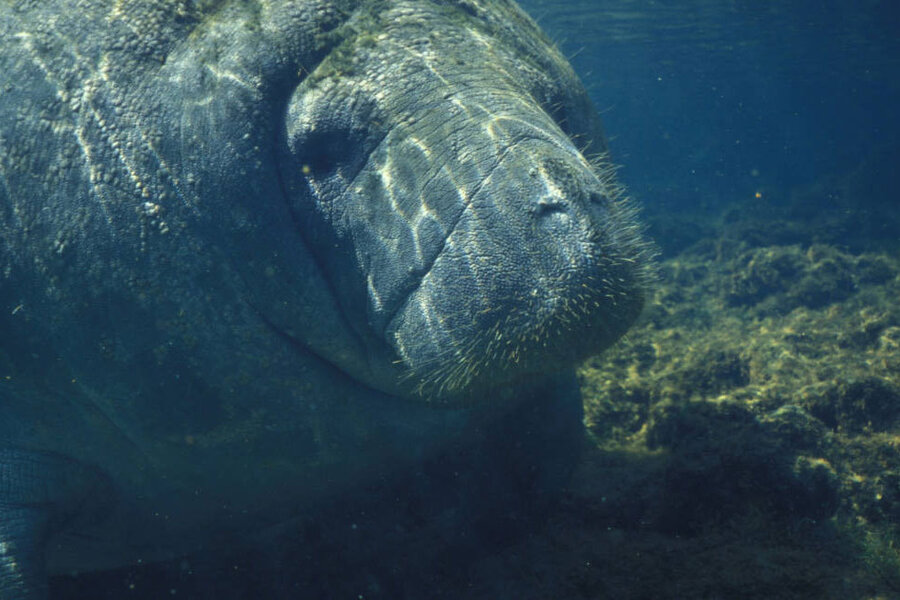Why are Florida's manatees dying again?
Loading...
An “unusual mortality event” has reared its head again in Florida’s Indian River Lagoon, claiming the lives of nine manatees since the end of May.
“They seem to be in good condition, they’re healthy, big animals, and suddenly they get an acute shock and a lot of them drown on the spot,” Martine de Wit, lead veterinarian at the Marine Mammal Pathobiology Laboratory of the Florida Fish and Wildlife Conservation Commission in St. Petersburg tells The Christian Science Monitor.
Since designating the state a “refuge and sanctuary" for manatees in 1978, Floridians have made progress in being good stewards for the gentle giants – enforcing boat-free sanctuaries and speed limits to curb death by speedboat, the manatee’s biggest killer. But pollution-driven algae blooms are taking their toll and the mammals depend on the warm water released by power plants, which might not operate in the same way for long.
Indian River, an estuary stretching along Florida’s east coast that is home to around 50 threatened and endangered species, was struck with an outbreak of algae blooms in July 2012, which correlated with the beginning of the manatee die-off that has claimed 166 of the animals so far. The die-off seemed to let up for nine months, but the latest manatee carcasses to be uncovered bear the hallmarks of the earlier phenomenon.
The algae bloom is to blame again, scientists predict – but microscopic algae don’t kill the 800 pound marine mammals directly.
“As far as cause of death, the exact mechanism isn’t known but the thought is that because of the algal blooms, you have a loss of seagrass, which is the manatee’s primary food source, and the result is that the manatees are finding another food source, macro algae, which is toxic in and of itself or has a toxic component,” explains Katie Tripp of the Save the Manatee Club in a phone interview with the Monitor.
“We need to do a better job of protecting our waterways. These algal blooms are a symptom of bad pollution management,” says Dr. Tripp.
The manatees have been recovered with little to no seagrass in their stomachs, Dr. de Wit told the Orlando Sentinel. Instead, their digestive systems were filled with seaweed.
Manatees face much bigger threats than this particular bloom, according to de Wit, first of which is watercraft collision.
Ninety-seven Florida manatees were killed in collisions with boats in 2009, the highest year on record, and a typical year sees more than 80 deaths. Slow-moving manatees have a difficult time avoiding speed boats and other watercraft, and propellers and boat hulls can inflict serious or mortal wounds. Most, if not all, living manatees bear scars from colliding with watercraft – collisions they likely survived only because boats were adhering to speed limits.
“Second to that is the loss of warm water habitats. In the winter they always have to migrate to warm water sites, whether that’s natural springs or industrial discharges from power plants. If they do not have that warm water, they will not survive the winter,” says de Wit.
An estimated half of Florida’s manatee population spend the winter next to power plants that suck up cold ocean water, use it to cool off, and then release the warmer water required by manatees, which seek temperatures above 68ºF.
"We need to figure out how to wean those animals" from power plant sites, Jim Valade, FWS's Florida manatee recovery coordinator, told Environment & Energy Publishing. "Quite frankly, we're just not sure how to do that." But he said the agency aims to find a solution before power plants close or phase out their cooling method.
West Indian manatees have rebounded by 500 percent since 1991, when as few as 1,267 were counted along Florida’s coasts. Today, there are more than 6,300 manatees in Florida, according to federal data. The US Fish and Wildlife Service proposed downlisting manatees from endangered to threatened status, reflecting this progress. This reclassification would not change the West Indian manatee’s current federal protections, but some worry that, despite recent population growth, the manatees' situation is not yet stable enough to move it off the endangered species list.
Manatee's favorite food, seagrass, faces another long-term threat. As climate change brings rising waters rise and people fortify the coasts to protect the infrastructure, “water is not going to be allowed to naturally flow in and create a shoreline,” FWC biologist Holly Edwards told the Monitor last year. “The water is going to get deeper. And when you get deeper, more turbid water, you get less sea grass.”








